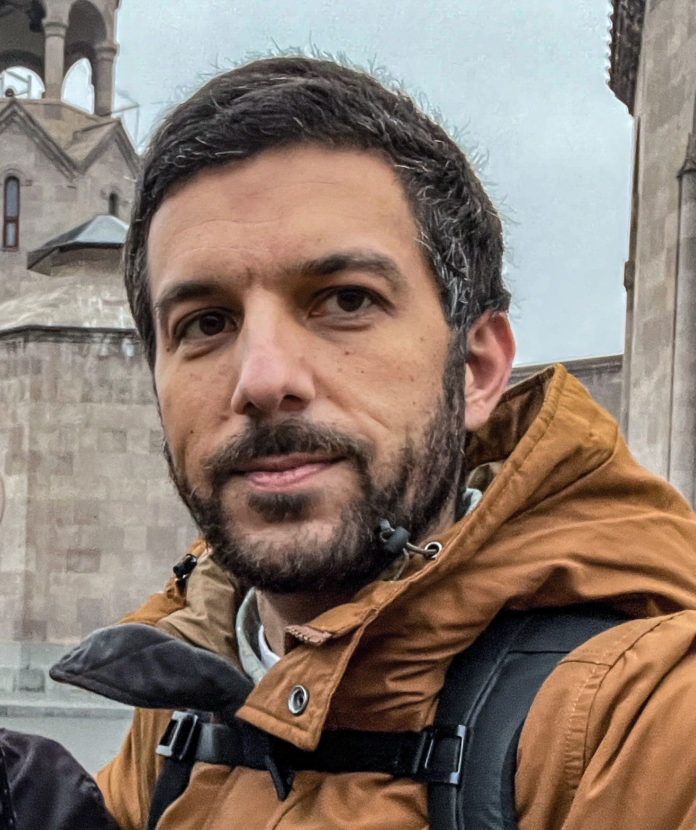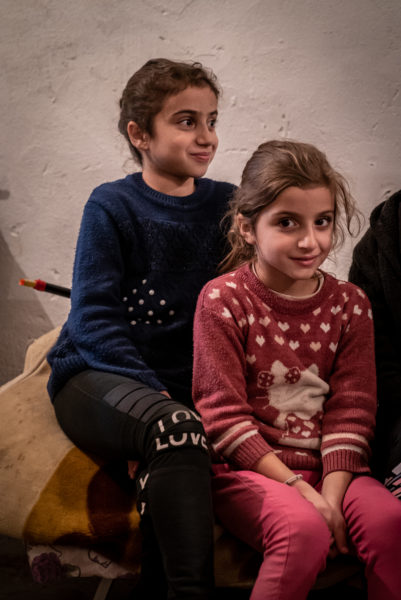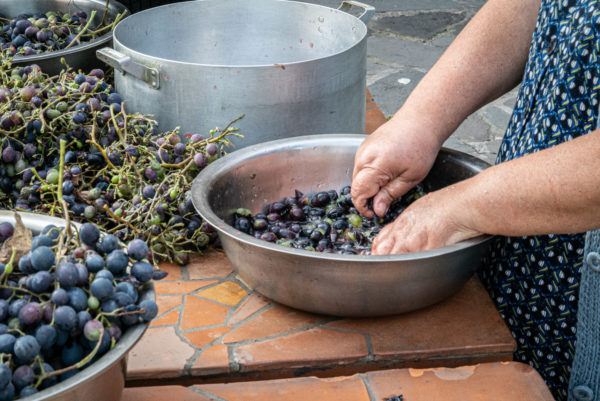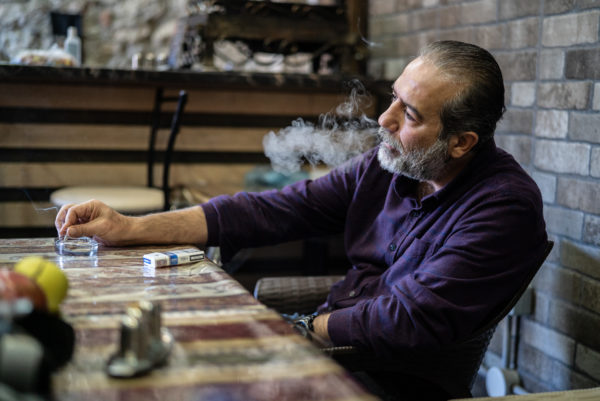by Harry Kezelian
NEW YORK — When war strikes, we watch television or read the newspaper, hearing about attacks, geopolitics, international relations, and intervention by world powers. The 44-day war in Artsakh was no different. Among footage of Azerbaijani drones and reports of Syrian mercenaries, Ezras Tellalian, a psychology student, photojournalist, and deacon in the Armenian Apostolic Church, wanted to bring to light something he felt was missing in the media intake of the Western world: the human side of the life of civilians.

Photographer Ezras Tellalian
Inspired by the resilience of the people of Artsakh, Tellalian has put together a book of photographs, Humanity During War: Artsakh, 2020. “I felt like it needed to happen,” he said. “I needed to do this to honor these people.”
During the war, Tellalian headed to Armenia to work as a photojournalist with Civilnet and document the turmoil of his ancestral homeland. A fourth-generation Armenian-American from Fresno, Tellalian earned his theological and Armenian studies degrees from the St. Nersess Seminary and was ordained a deacon; he is currently working on his doctorate in psychology at the New School in New York City.
Serendipitously meeting journalist-writer Michael Krikorian from Los Angeles on the plane to Armenia, the duo headed to Artsakh for their documentary mission. In addition to acting as the photographer, Tellalian was also the translator for the American-Armenian team.
“I never intended to put a book together,” said Tellalian. “I went as a photojournalist and worked with Civilnet, providing them photos. Going through the photographs, I didn’t feel satisfied. I wanted there to be better understanding of what we were doing and what we were seeing.”
Tellalian pieced together the book from his photos of everyday civilians, people he knew personally and befriended, photos that were “not usable” for Civilnet’s typical straight news coverage. Through the book’s many photographs, he has brought a larger picture of the humanity he saw in Artsakh to the eyes, and hopefully to the hearts of the Diaspora and all people across the world.
A Story of Resilient Armenians
The book is 50 pages long and includes 37 photographs, split into sections telling the story of individuals and groups of people from Artsakh; some stayed in Artsakh during the war and others took refuge in Armenia proper. Each section is preceded by a short poem-like introduction.
Tellalian shared his impression of the Armenian spirit that he saw when he visited Artsakh. “There’s a remarkable resilience of our people; of humanity [in general]…but there is something distinctive about our people.” He pauses to muster the correct words, then said, hesitatingly, “Not everyone [around the world] believes in Christianity in the same way. But there is something in our culture that resists hate and the temptation to be angry. There was a life [in Artsakh during the war] that wasn’t centered around killing and destroying. It was focused on living and surviving and honoring those heroes by doing so.”
The author continued, in relation to the broader reasons for the war: “We were protecting our lands; our homes. Not trying to take someone else’s home. And from the Azerbaijani perspective, they are trying to take their lands back too, but that disregards a lot of history. There was a different sense on this [Armenian] side of the war. There’s just a desire to be left alone and live in peace. That doesn’t seem to be a shared desire with the Azeri government.”
In Tellalian’s impression, the individuals he met in Artsakh seemed to embody this ethos. The photos presented in the book also tell the story of resilient Armenians who are full of life and have the will to continue.
The first photographs in the book are of a band of youthful musicians from the music school in Artsakh, who had fled to Yerevan. “We met them on the street because they were raising money,” Tellalian said. “We went into a café and Mike [Krikorian] was interviewing them. The servers start bringing drinks and cookies for the kids. Arshak [the driver] mentioned to the owner that they were refugees and the owner gave them a bunch of stuff. There was a woman in the corner who decided to record them. They were moved by one of the songs and they couldn’t keep going.”
With that introduction to the resilient spirit of Artsakh, Tellalian and Krikorian continued into the historic Armenian territory which was under attack.
A Shepherd Doesn’t Sit Home Waiting For The Sheep
The first individual in the book that the team met in Artsakh is Fr. Varazdat. He was one of the head military chaplains during the war. Tellalian said: “Ter Varazdat went out on the front to baptize soldiers and do badarak on the front lines, and there were times when he didn’t know if he would make it back. One of his deacons didn’t make it back. There was just a different spirit, it seemed.” Currently, Fr. Varazdat is back in Yerevan where he continues to minister to soldiers from the St. Anna church. “He’s very charismatic, always with the soldiers,” Tellalian said. “A shepherd doesn’t sit home waiting for the sheep to come home.”
The next individual, also a clergyman, will be familiar to many readers: Archbishop Pargev Martirosyan, the Primate of Artsakh. Tellalian reminisced that he first met him in Shushi on a pilgrimage organized through St. Nersess Seminary in 2003, humorously recalling that along with being introduced to the archbishop, he was also introduced for the first time to the high-octane tuti oghi (mulberry liquor).
Upon returning in 2020, “He remembered us. That was one of the times I wasn’t translating, because Pargev Srpazan speaks fluent English. He’s full of life, the fire is still there. He’s carried from the 1990s to 2016 to 2020.” Tellalian notes that in his opinion, this is all the same war. Armenians became complacent, he opines. “While they [Azerbaijan] were building up their army and a culture of hate and this propaganda machine, we [diasporan Armenians] were doing what we thought we were supposed to be doing, going [to Artsakh and Armenia] and hanging out, not arming and training and being more foresighted.”
As to Archbishop Pargev, “He carried them through three decades of war,” Tellalian said. “He came [to the US] after the war for some procedures. The guy went through a heart attack and still ticking with the same fiery hope that he had. Some people look at a guy like this and say, ‘how can you still have hope.’ It’s the notion of faith as a gift.” Tellalian relates that Martirosyan was leading the faithful in prayer throughout the day from a bomb shelter underneath the Ghazanchetsots Cathedral in Shushi, where an attack at any moment could wipe them out.
Life Under Siege
Tellalian next takes us to a bomb shelter in Stepanakert. “They were friends of Lika,” he said. “Lika worked for Civilnet and was kind of a guide. She connected with the family. They were just finishing up making the tanov [a yogurt-based soup also known as tanabour or spas] as we arrived. We weren’t going in as journalists but we were welcomed as guests. I sat in the room with the TV. There’s a room with warmer light and a room with cooler light that has the TV and food. They’re feeding me food from the pantry, vegetables. The guy gave me a shot [of liquor]” None of these shots were usable by Civilnet. They weren’t material for that outlet, but they’re priceless to me.
Another memorable section of Tellalian’s book was the wedding of a soldier and his bride, a story which was widely reproduced in the international press with the help of Tellalian and other journalists. “There’s a press center for international journalists [in Artsakh]. They kept track of credentials and who was there and where they were. They didn’t tell us where we were going or what we were doing. They said come to the office and we’re going on a tour. We gathered in the morning and we end up in Shushi and they say there’s going to be a wedding. This is the church [Ghazanchetsots] that was shelled twice, the double-tap method that Russia is using in Ukraine.”
Tellalian recalled that he was able to gain special access due to his status as a deacon. He asked the presiding clergyman if he could participate in the service and was allowed to do so. Being able to participate in the couple’s special day and a celebration for the community was also meaningful to him. “The wedding I could shoot from the bema because I’m a deacon and I knew the service, so there were certain privileges I had because of that. The shot of the wine. [chalice of wine used in the Armenian marriage service]. I sang with [the priest] and did a couple of karoz-es [chants]. That was another way to plug in, through the services through the church community.”
Tellalian mentions that the Artsakh authorities apparently desired to publicize the wedding as a human interest story by inviting international journalists, but were extremely secretive until the moment Tellalian and others arrived at the church. The reason of course, was security: “Had there been any sort of leak, I have no doubt the Azeris would try to hit it again with us all inside,” said Tellalian. He adds, “There was something really symbolic about it. It was really moving. You don’t get married if you’re hopeless.”
Repatriates and Returnees
The book also profiles Hovig Asmarian, a Syrian refugee who fled with his family to Artsakh. He has opened a restaurant with his wife in Stepanakert, named “Samra,” which was the only one to remain open during the war.
“His wife was back and forth, she made all the food,” Tellalian relates. The Asmarians started off feeding the soldiers, but because the types of food they were making were the same as the soldiers’ rations, they instead began to cook up what they called “Geroosoos” soup. Roughly translated as “eat it and shut up,” the soup is made of motley ingredients, which its name suggests one is better off not asking about. “He doesn’t take a dram from anybody,” said Tellalian. “He accepts food donations, and kept his restaurant open throughout the war.”
Tellalian hopefully relates that both Hovig Asmarian as well as Mariam Sargsyan, who was the bride in the wedding Tellalian photographed, both work for Artsakh Public Radio. Hovig has a show called “Spiurki Tzayne” (Voice of the Diaspora) where he utilizes Western Armenian, and Mariam talks about war heroes.
In regard to Hovig’s restaurant, Tellalian said, “By virtue of his presence and hospitality and spirit, it was a center, as small as it was.” Tellalian continues, “He showed us his garden (depicted in the book). He’s in his paradise.” And in response to writer Krikorian asking the couple where they would go if they could leave, the reply was “where would we go?”
Another returnee was Dr. Gevorgyan from Glendale. He returned as soon as the war broke out. “We were waking up to it Sunday morning, and Monday he’s telling his wife they need me there,” Tellalian said. Gevorgyan’s wife protested that his family in California also needed him. He replied the people of Artsakh needed him more. Tellalian found him in a makeshift hospital in the village of Gishi, where Gevorgyan and his crew had retreated from Marduni. “He spent a month and a half on the frontlines in the hospital, doing surgery over and over again”
Armenia’s Future
One of the most powerful aspects of the photographs are how they portray the hope and vibrancy in the faces of young people and children. Anyone looking through the book would think this bodes well for Armenia’s future. One of the people the author met on his journey who most embodied this was Lika Zakaryan, to whom the book is also dedicated.
Zakaryan has gained a bit of international notoriety since that meeting. During the war, she was also working for Civilnet as a reporter, reporting on the events with a videographer who is now her husband. An Artsakh native, at the time, she was just starting classes in journalism but in reality, “the war was her teacher,” said Tellalian. She started writing a diary in Russian and posting it, gaining the attention of Russian-speaking around the world. It is now available as a book in Armenian, Russian, and English (https://www.44daysbook.com/.). In Zakaryan’s diary, the world saw “this amazing young woman who is bright, spirited, and passionate, but not hateful. The anger, for her, was directed toward the international organizations who could have stopped it,” Tellalian said. The website for Zakaryan’s book describes it as “a definitive chronicle of those 44 days.”
At the time, Zakaryan was starting to get some coverage, and Salpi Ghazarian of the University of Southern California, one of Tellalian’s and Krikorian’s mentors, suggested that they interview her. It was the first thing the duo did when they got to Artsakh. “The first night we got to Artsakh, we put on the gear, drove without lights through the Lachin corridor. At a certain point our driver Arshak stopped. He was a seasoned war veteran from the 1990s. We passed Shushi to go meet Lika, we went and they were staying in a bunker in Stepanakert. She was just a lovely person and we bonded, she became like a little sister to me. I was with her when she found out her cousin was captured.” The photographs of Zakaryan depict her with her brother and her father, another heroic figure of the book. “He was going around giving supplies to people. He was delivering them in a car, which was risky for him [because of the possibility of being targeted by the enemy].”
Arpi is another young woman from Artsakh pictured in the book. “She fled her home, her brothers were fighting,” said Tellalian. “Her faith was grounding her. She was reading scripture the night everything started. I kept pushing her to say what it was. She said it was ‘unless a grain of wheat falls into the earth and dies, it remains alone; but if it dies, it bears much fruit.’” The quotation, from John 12:24, is prominent in the Armenian requiem service. “She and the women were at this resort hotel that a lot of refugees were put up in,” said Tellalian.
The photographer, who took pictures of these woman making wine, states: “they were at this resort hotel in Goris. It was gorgeous. I’m listening to the river and thinking it would be a lovely place to vacation. And we hear missiles being fired from down the way.” He continues, “they’re refugees, but they’re going to work. They are cleaning the grapes and smashing them. There was a teenage kid who was buzzed walking around and picking the grapes from the trellises.”
Tellalian concludes that wine-making is a sign of hope. “You don’t make wine, which is going to take time to ferment, unless you think you are going to drink it.”
The book can be ordered through its official website, or from Abril Books in Glendale.
Tellalian’s personal photography site can be found here:























































